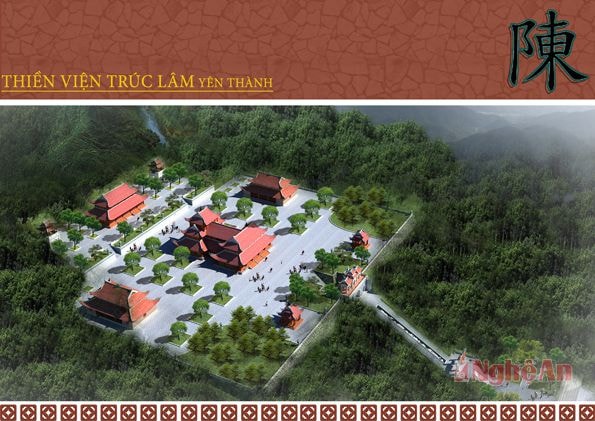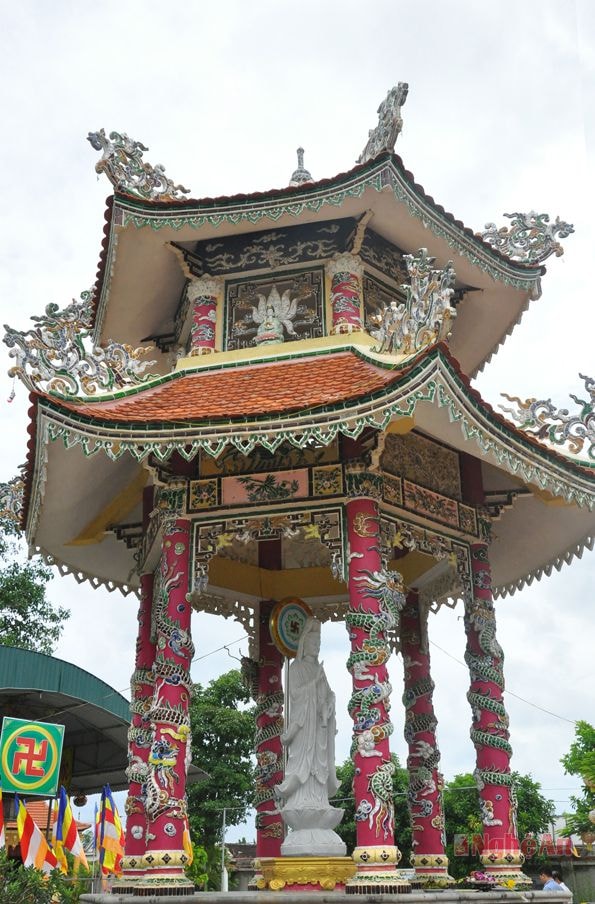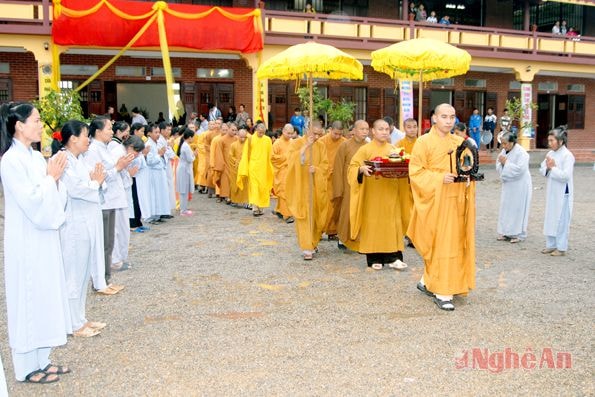Awakening the potential of community tourism in Yen Thanh
(Baonghean) - The name of the place "Yen Thanh" (formerly Dong Thanh) itself reflects that this is a peaceful and quiet land, where many famous people, scholars, and revolutionary patriots were born or established their careers. And it is a land of prosperity and is famous for: "Nghe Dong Thanh/ Thanh Nong Cong", or "When there is no water, there is water source/ When there is no rice, there is rice from Dong Thanh"...
Thus, since ancient times, this land has been full of charm and appeal. These things also show that there is a rich source of “tourism resources” here that not every place has.
| RELATED NEWS |
|---|
 |
| Perspective of Truc Lam Yen Thanh Zen Monastery. |
Places that hold people's feet!
Writer Nguyen Xuan Phau left behind some poetic verses with deep affection and nostalgia: “The Dinh River, once upon a time, had two banks of memories/ The three-layered Gam Ru, several miles of love.” The Dinh River and Gam Ru are places to deposit feelings of love and nostalgia for the land and people of Yen Thanh. Moreover, they are also symbols, places that crystallize and preserve the spiritual energy of the land and people throughout history.
Regarding the land west of Yen Thanh, patriot Le Doan Nha once wrote "Remembering the time when the mountains gathered heroes/ Quy Lai religion built Dong Dinh swords to ring", that was the memory of the time when under the righteous flag of Le Loi, General Dinh Le took this land to gather to fight the Ming invaders. Giam sinh Ngo Tri Hop in the book "Dong Thanh phong tho ky" also summarized the "eight beautiful scenes" of the Dong Thanh area, including the spring clouds on the top of Ru Gam and the lotus pond of Dieu Oc village. Revolutionary Phan Dang Luu affirmed "Dinh Ru Gam River is a fairyland"... It can be seen that for a long time in this land there has been a complex of relics and famous landscapes, where each name of land, village, mountain, river is more or less associated with legends, stories that mark the shining lights of history.
Right at Ru Gam, a complex of relics of Temple, Gam Pagoda, Cua Ong Temple and Bach Y Princess Temple has been formed since ancient times. Gam Temple and Pagoda are relics that appeared very early, around the beginning of the 10th century. They are relics with unique architectural and artistic values, still bearing the mark of the philosophy of "three religions of the same origin", most notably the mark of Truc Lam Zen sect.
Around the Temple and Gam Pagoda religious center, there is also a large "reserve" of addresses that can be connected to become destinations. Among them, many relics have unique architectural and artistic values, located in the middle of the countryside with strong rural features of the Central region, or in semi-mountainous areas with beautiful mountains and rivers, which are great potential for developing rural tourism such as: Duc Hoang Temple (Phuc Thanh), Bao Lam Communal House - Pagoda (Hoa Thanh), Bao Nham Stone Church (Bao Thanh), Sung Communal House (Lang Thanh), Hau Communal House (Bac Thanh), Ca Communal House (Hoa Thanh)... Some revolutionary historical relics in places with beautiful landscapes such as: Uncle Ho's Memorial Site visiting Vinh Thanh (Vinh Thanh), Phan Dang Luu Communal House (Hoa Thanh), Trang Ke Relic (My Thanh)...
Phan Thuc Truc, the first laureate of the Imperial examinations, once wrote, "Yen Thanh has a flat land, the people are pure, and the education and examinations are the best in the district" (Dien Chau Palace History). Talking about Yen Thanh is also talking about the land of mandarins and studious people, and is also the birthplace of many heroes. From the Tran Dynasty to the Nguyen Dynasty, Yen Thanh district had 24 people who passed the imperial examinations from the first laureate to the second laureate. Among them, there were 4 laureates who were famous. The first laureate of the imperial examinations, Bach Lieu - the one who started the imperial examinations in Nghe An; and the story "A family of three laureates sitting/A motherly example for the world to look at together" with 3 generations of grandfathers, fathers, and sons, all being laureates: Ho Tong Thoc, Ho Tong Don, and Ho Tong Thanh, is a unique phenomenon in the history of imperial examinations; in addition, there were Doctor Tran Dinh Phong, the first laureates Phan Duy Thuc, the first laureates Phan Tat Thong, and the third laureates Phan Thuc Truc.
Yen Thanh has the terrain of "a granary in front, a money chest behind", advancing can attack, retreating can defend, so since the period of Chinese domination, the Early Le Dynasty, the Tran Dynasty, this was the headquarters of Chau Dien, of Dong Thanh. This land was also a military base, a base for gathering soldiers to nurture the flame of patriotism, the spirit of self-reliance. Therefore, this is a place where eco-tourism can be combined with historical tourism, returning to the lessons of love for one's roots, love for one's homeland and country. Stories about the names of mountains and rivers such as Vu Ky cliff, Voi cliff, Dong Tho cave, Dinh river,... still sparkle with historical and humanistic values. The anecdotes about Den citadel, Thong pagoda, the stories about the heroic King Phan Canh Quang, about the scholar Nguyen Xuan On, the deputy general of the Can Vuong movement Le Doan Nha, the patriotic landowner To Ba Ngoc, about Tac Bay - Lanh Ngoi, the patriotic martial arts bachelor Chu Trac,... and especially the example of the Party's outstanding revolutionary soldier - comrade Phan Dang Luu, truly show that every step on this land is like contacting and meeting with the sediments and convergence of a rich history.
 |
| The sophistication in Gam Pagoda architecture. |
Located in the center of Northeast Nghe An, Yen Thanh also has an advantage in attracting tourists because it has an ecological forest complex with rich and diverse flora and fauna such as Xanh Gam forest, Lang Thanh primeval lim forest, Hau Thanh and a forest area stretching from the North to the West to the South of the district (Duc Thanh to Son Thanh).
With over 220 rivers, lakes and dams, it not only provides irrigation but also creates a landscape of a beautiful countryside with bright scenery. Many destinations such as Ve Vung dam, Quan Hai lake, Lo Noi dam, Sat dam, Xuan Nguyen lake, Dieu Oc lotus pond, Len Vu Ky, Thien Tao pagoda... or natural bird gardens, typically the bird garden of more than 2 hectares of Mr. Vu Van Ngan's family in hamlet 10, Ly Thanh commune, Yen Thanh district, stork island in Ve Vung lake.
Associated with historical and cultural relics are traditional folk festivals, where folk cultural activities imbued with the colors of wet rice farming residents take place such as: Duc Hoang Temple Festival (Phuc Thanh), Gam Temple and Pagoda (Xuan Thanh), Ca Temple (Nhan Thanh), Dai Dien - Dinh Mo (Hau Thanh), Ca Temple (Hoa Thanh), Canh Temple (Duc Thanh)... Yen Thanh is also one of the cradles of the movement of culture, folk art, and mass art. There are many villages here that preserve unique folk cultural and artistic activities such as: Tuong singing in Xuan Thanh, Vinh Thanh, Lang Thanh Cheo singing, Nghe Tinh Vi and Giam folk songs in Phuc Thanh, Dong Thanh...
Being a land with mountainous areas, lakes and dams adjacent to semi-mountainous areas, plains with fields as far as the eye can see, this place has many typical products that are both traditional and modern. In recent years, the place name Yen Thanh has been known on the national map of varieties with fragrant rice, Vinh Thanh herbal rice; Dong Thanh and Minh Thanh oranges; Kim Thanh and Minh Thanh peaches; Nam Thanh, Son Thanh, Ly Thanh, Long Thanh mushrooms...; Minh Thanh, Quang Thanh, Tay Thanh honey...
Yen Thanh also maintains and develops traditional craft villages that have existed for hundreds of years such as: Vinh Hoa vermicelli making village (Hop Thanh), Yen Hoi bamboo and rattan weaving village (Do Thanh), Yen Bang incense stick making village (Phuc Thanh), clay pot making village (Vien Thanh), Long Thanh sedge mat weaving village...
 |
| Sacred procession. |
Opening the "grain warehouse, money chest"
On the green mountain landscape, lush rice fields, urban and village landscapes interwoven with many classic and modern features, both pure and fresh countryside features, and convenient in connecting with other nearby destinations, Yen Thanh promises to become a land of strong attraction. In Yen Thanh, specialized agencies, experts on community tourism in the world and in the country have affirmed that this is the "promised land" for types of tourism: Spiritual - cultural tourism; resort tourism, eco-tourism, culinary tourism, historical - research tourism...
Within a radius of 20 - 70km, visitors can go to the sea to Dien Thanh beach, visit Cuong temple - Cua Hien (Dien Chau), swim at Lu beach (Nghi Loc), Cua Lo beach... go to Nam Dan to visit Kim Lien relic site, the hometown of President Ho Chi Minh, Phan Boi Chau relic site, or go up to the West of Nghe An to visit Giang Son hot mineral water area (Do Luong), Pu Mat National Park (Con Cuong), Ho Chi Minh road milestone 0 (Tan Ky)... Therefore, the policy of developing community tourism in Yen Thanh can be considered the "key" to open the "grain warehouse, money chest", both ensuring the preservation and maintenance of traditional values, environmental protection, labor use, and contributing to spreading scientific - social and humanistic values.
In recent years, the District Party Committee, People's Council, and People's Committee have focused on investing in developing tourism infrastructure to better serve the needs of tourism development. Up to now, the traffic system to Yen Thanh district and tourist attractions is beginning to take shape and is being renovated, upgraded, and expanded. Some accommodation facilities have been upgraded and newly built, becoming more and more spacious and modern. Up to now, in Yen Thanh area, there are over 30 accommodation facilities, including 2 hotels; nearly 20 large and small restaurants, attracting and creating jobs for nearly 1,500 local workers. Along with that, the Provincial People's Committee approved, the Provincial People's Council included in the Resolution on the construction of the Gam Temple and Pagoda spiritual eco-tourism area and on April 4, 2015 (ie February 16, At Mui year), the District People's Committee coordinated with the Pagoda to organize the stone laying ceremony of Truc Lam Yen Thanh Zen Monastery, starting the construction of the An Quoc Great Buddha Statue, which is an important starting step in the construction of the Gam Temple and Pagoda spiritual eco-tourism area.
Reporter group
